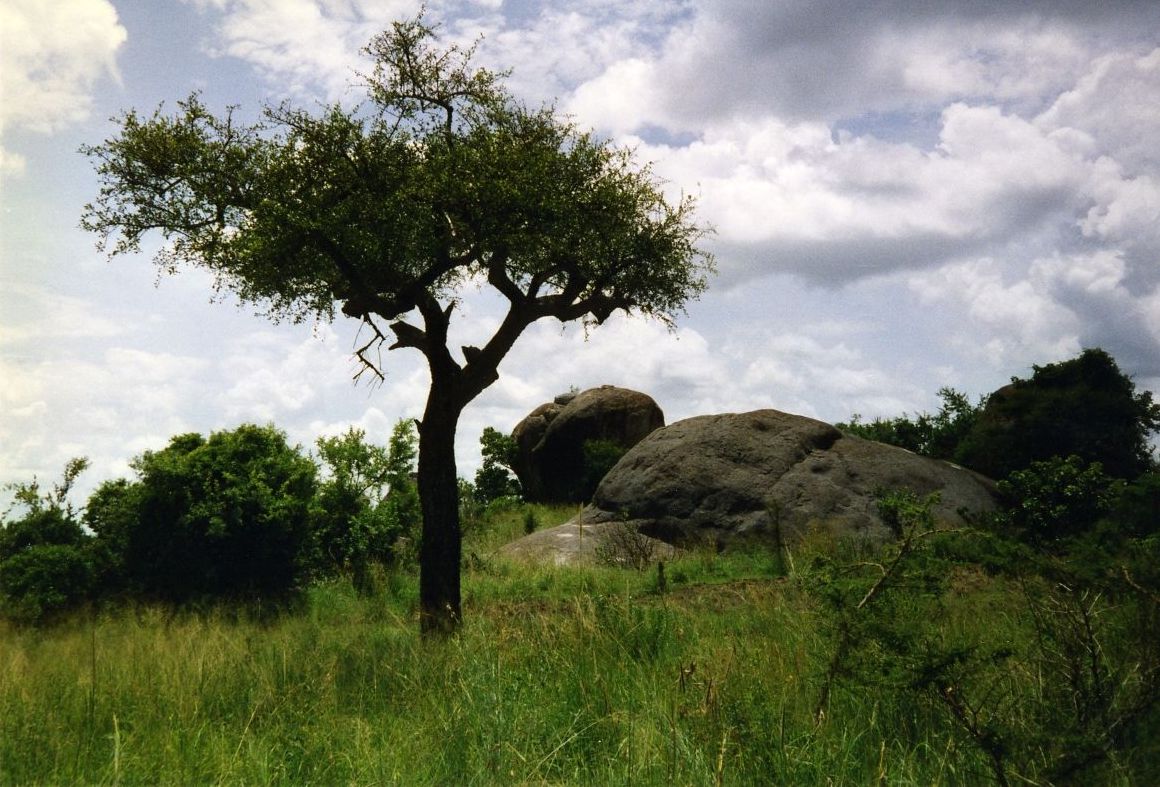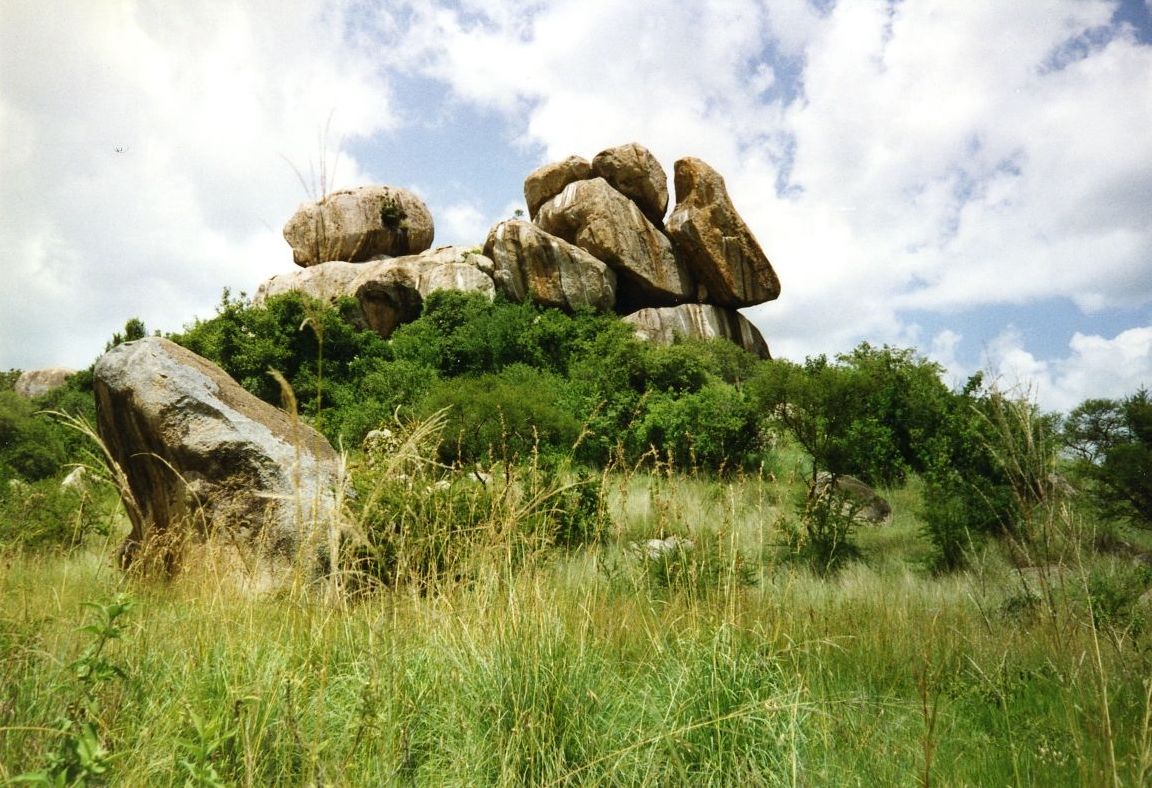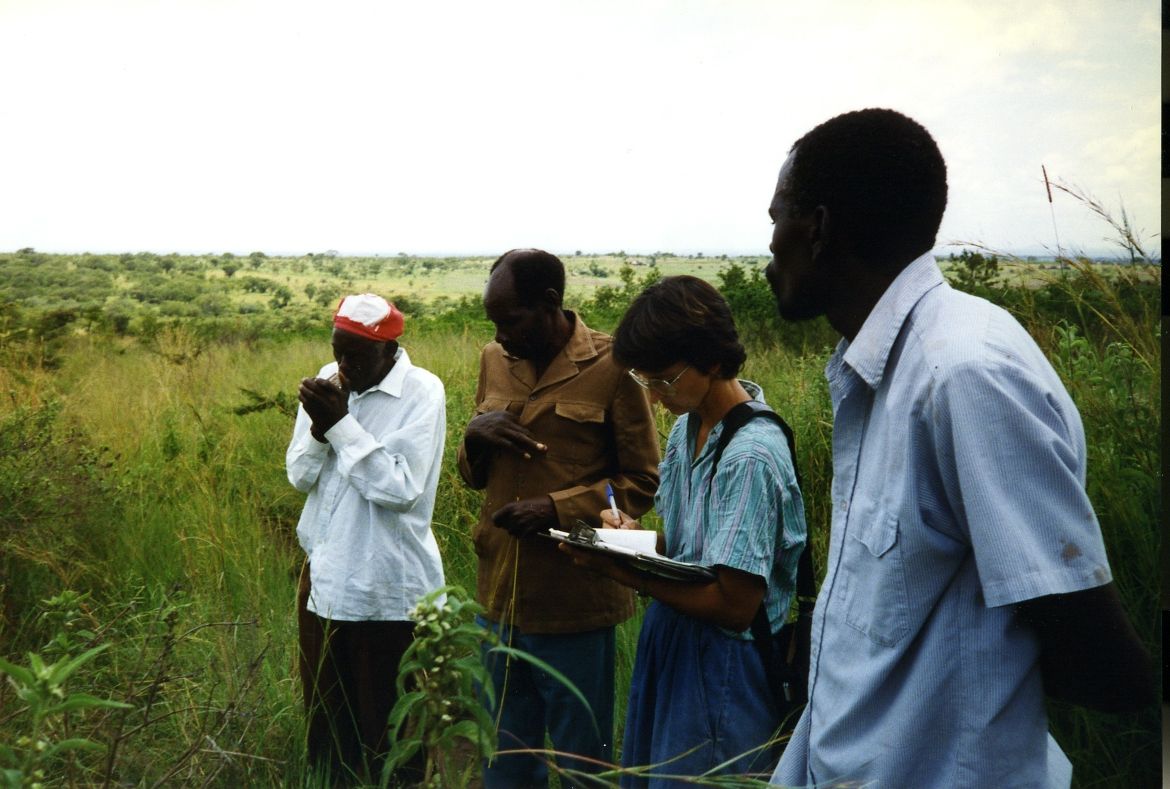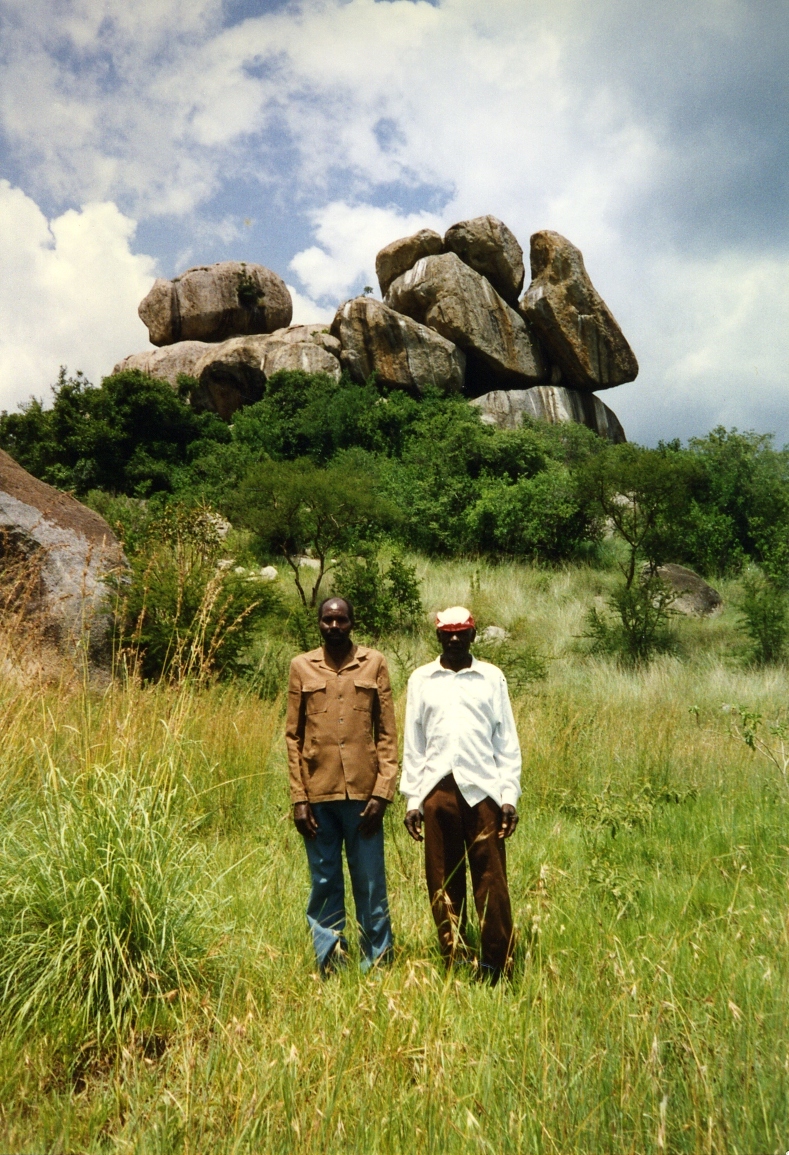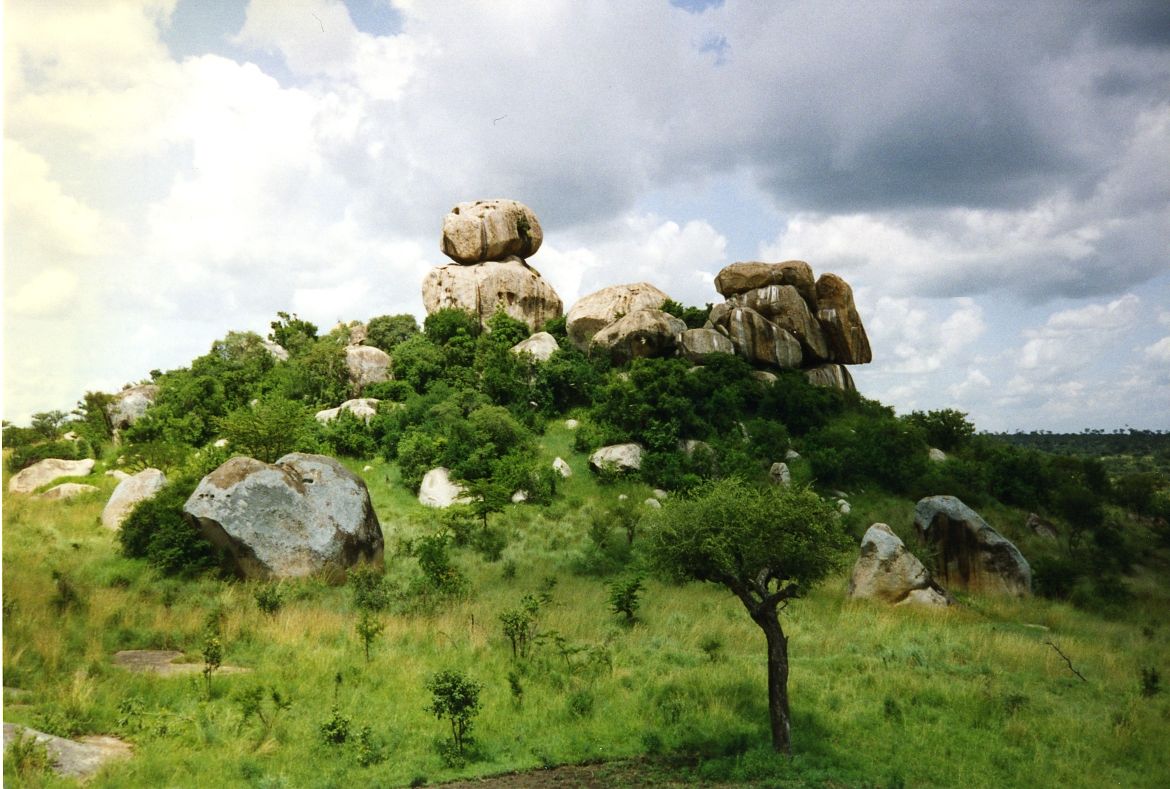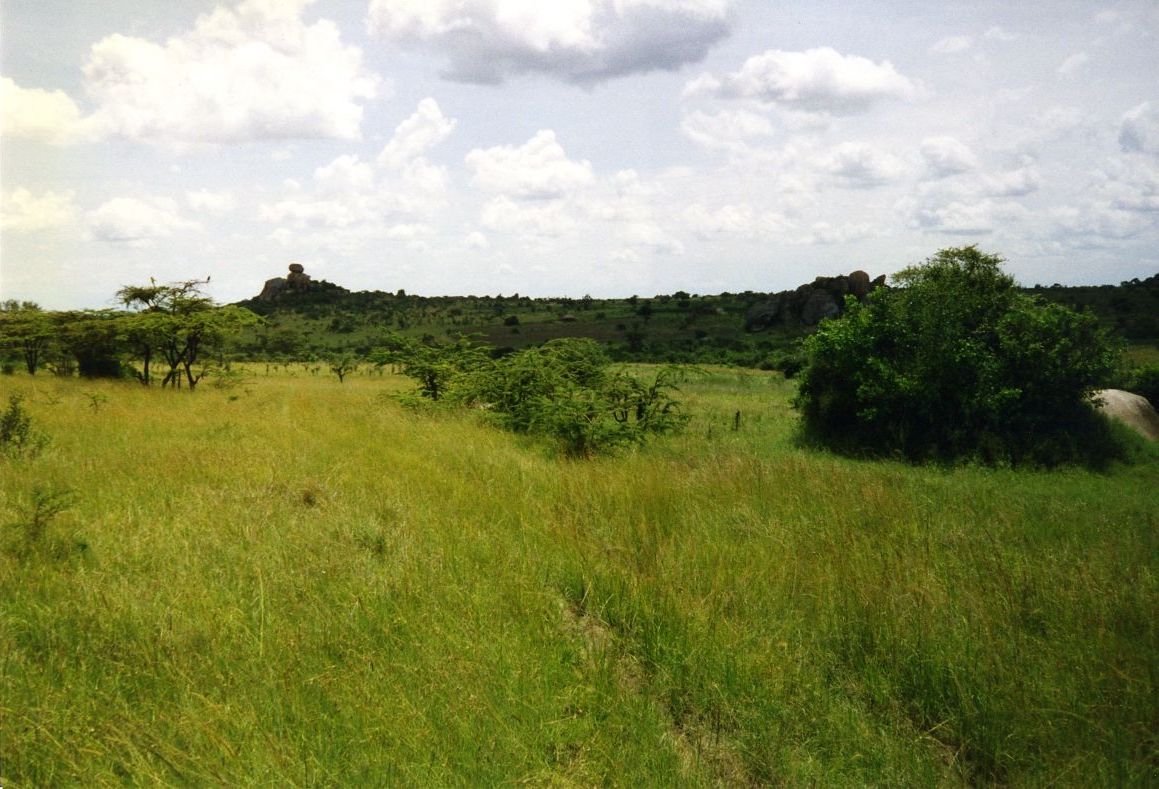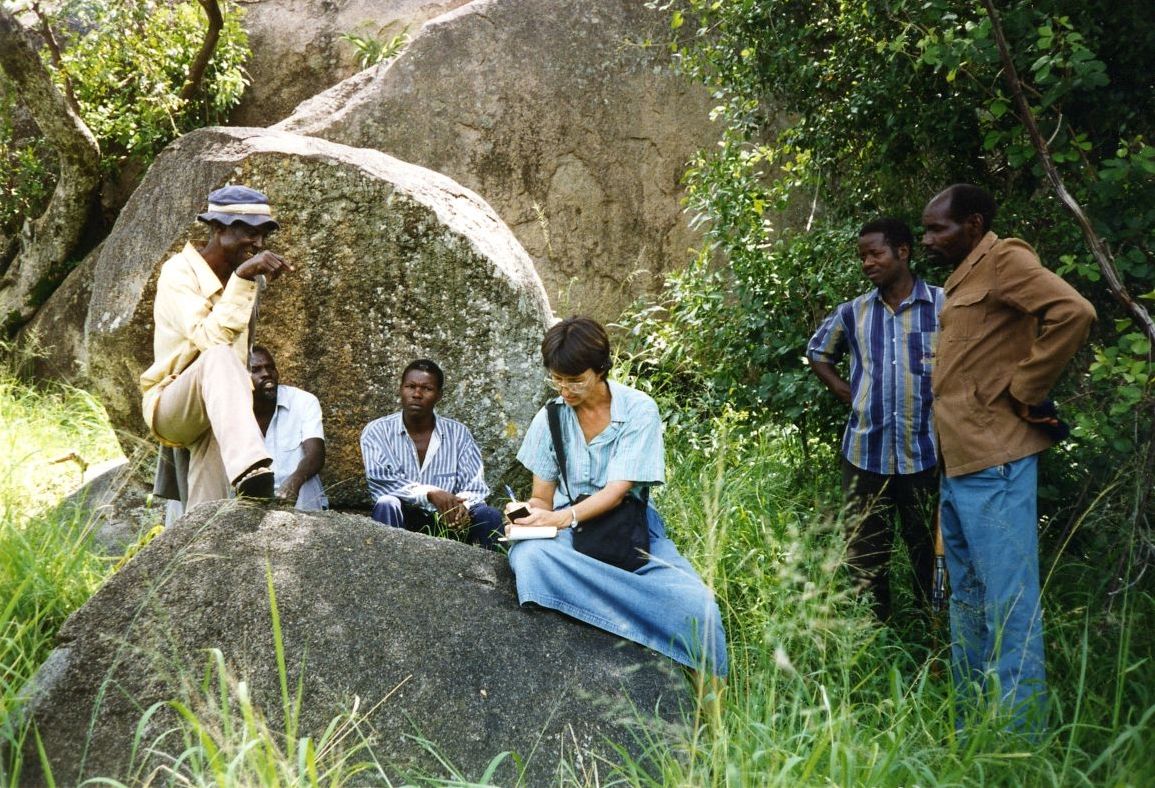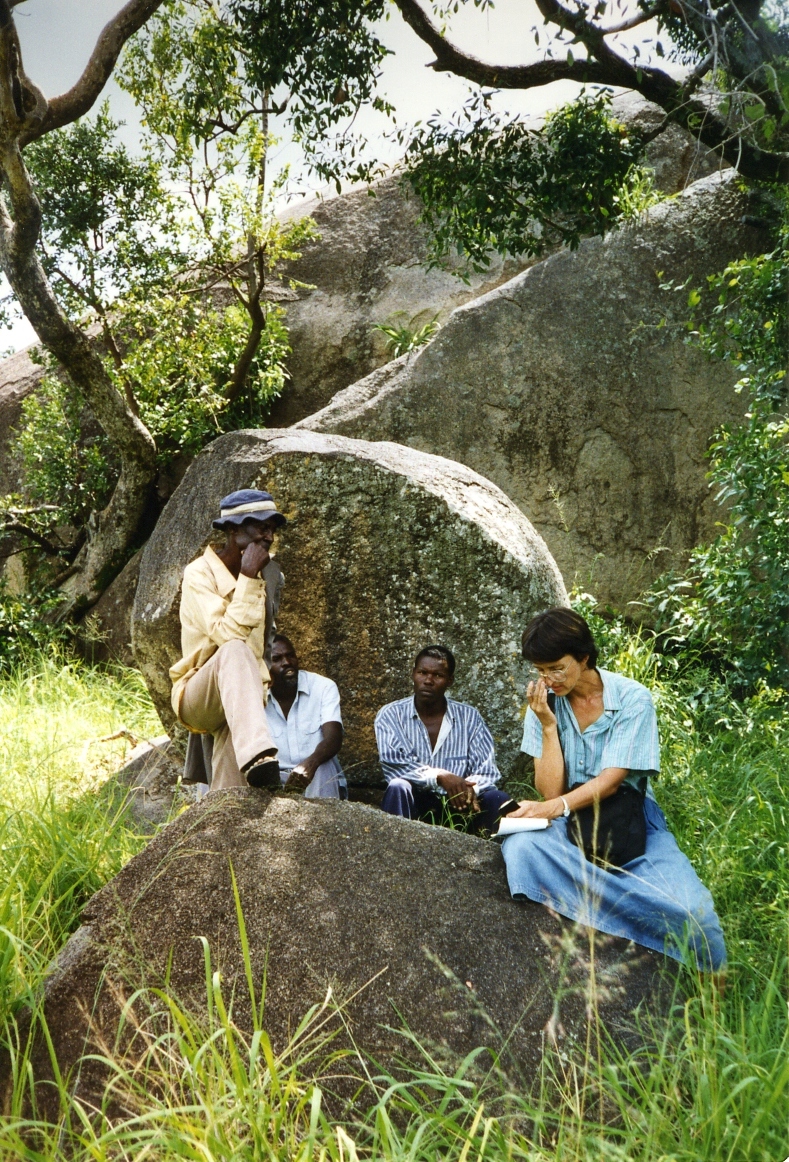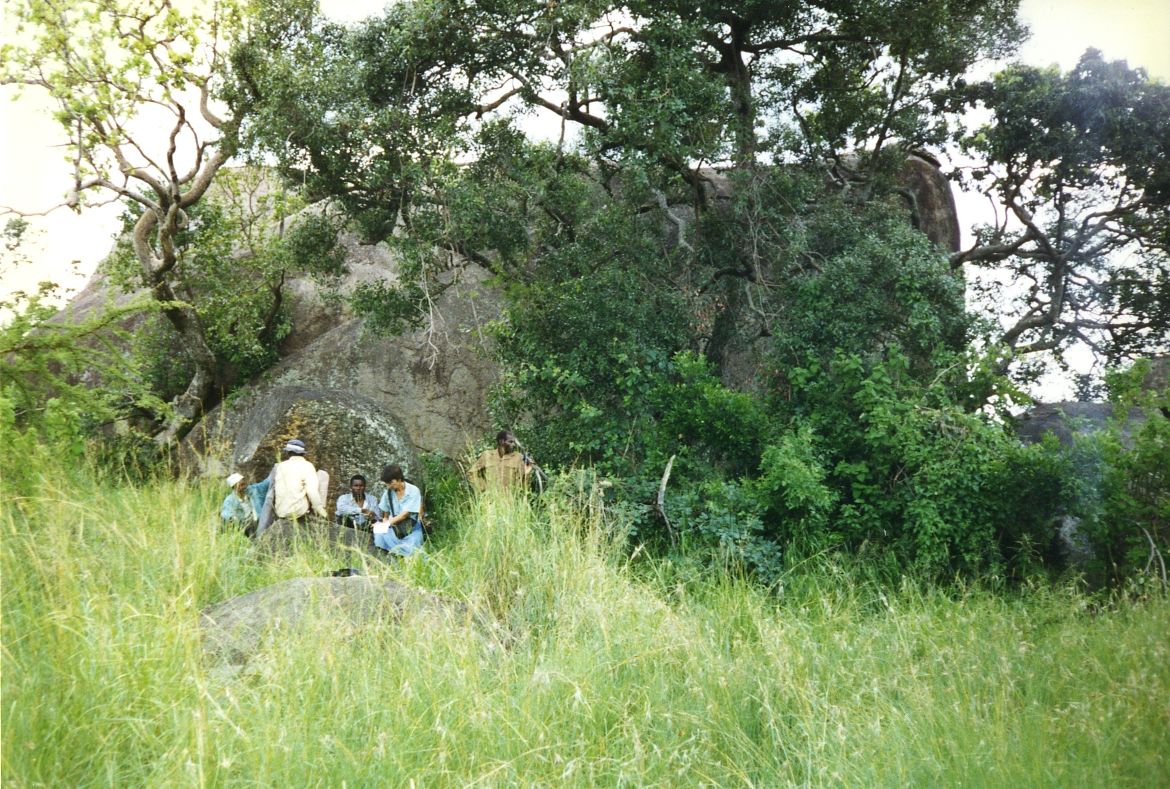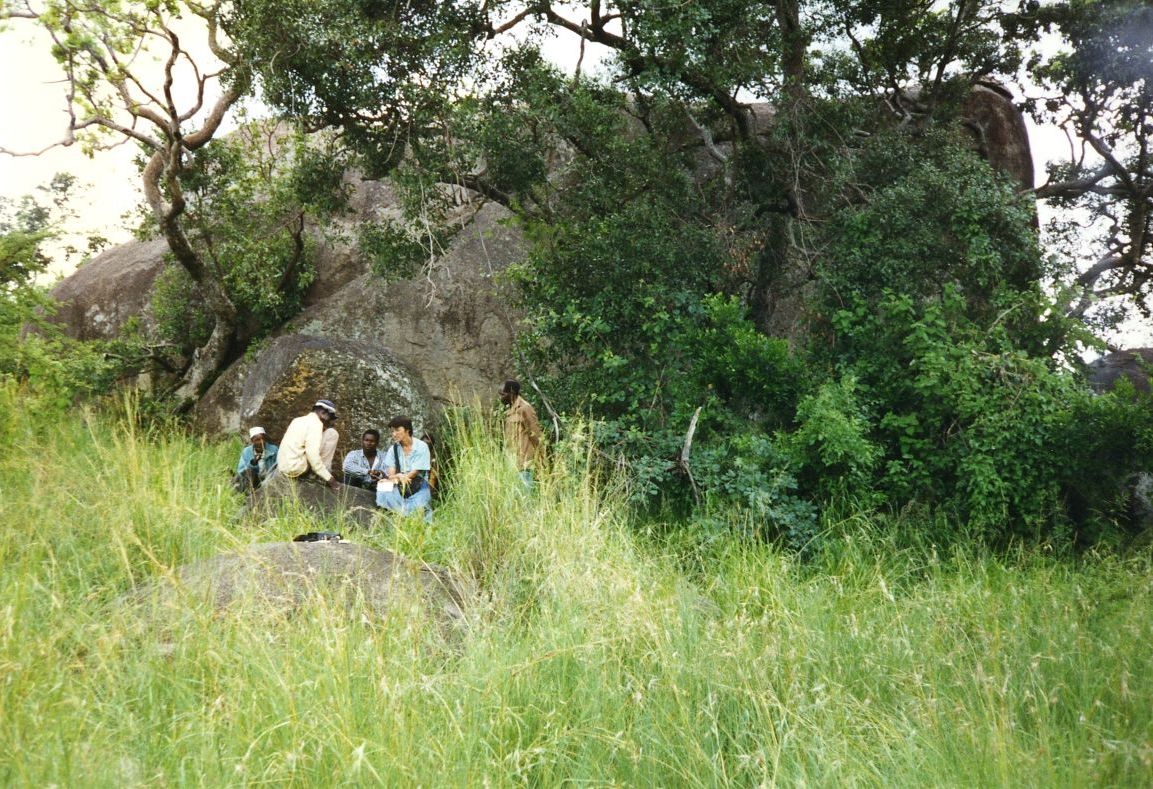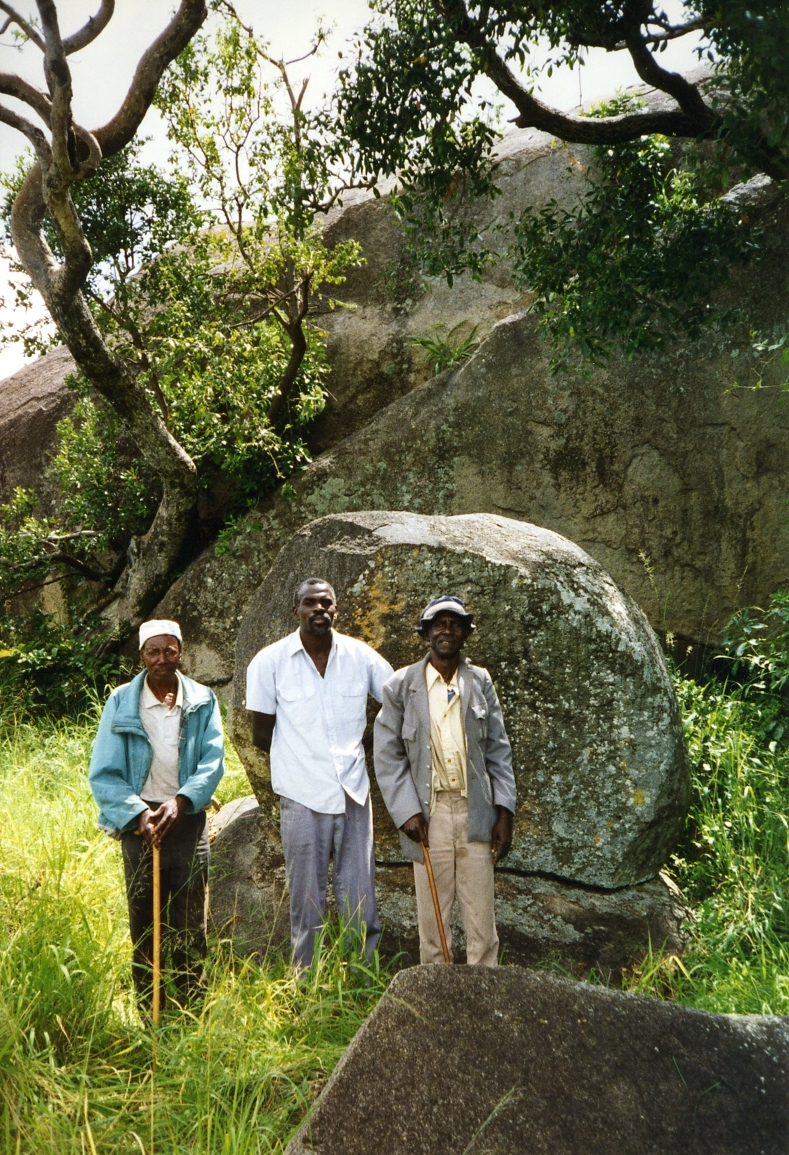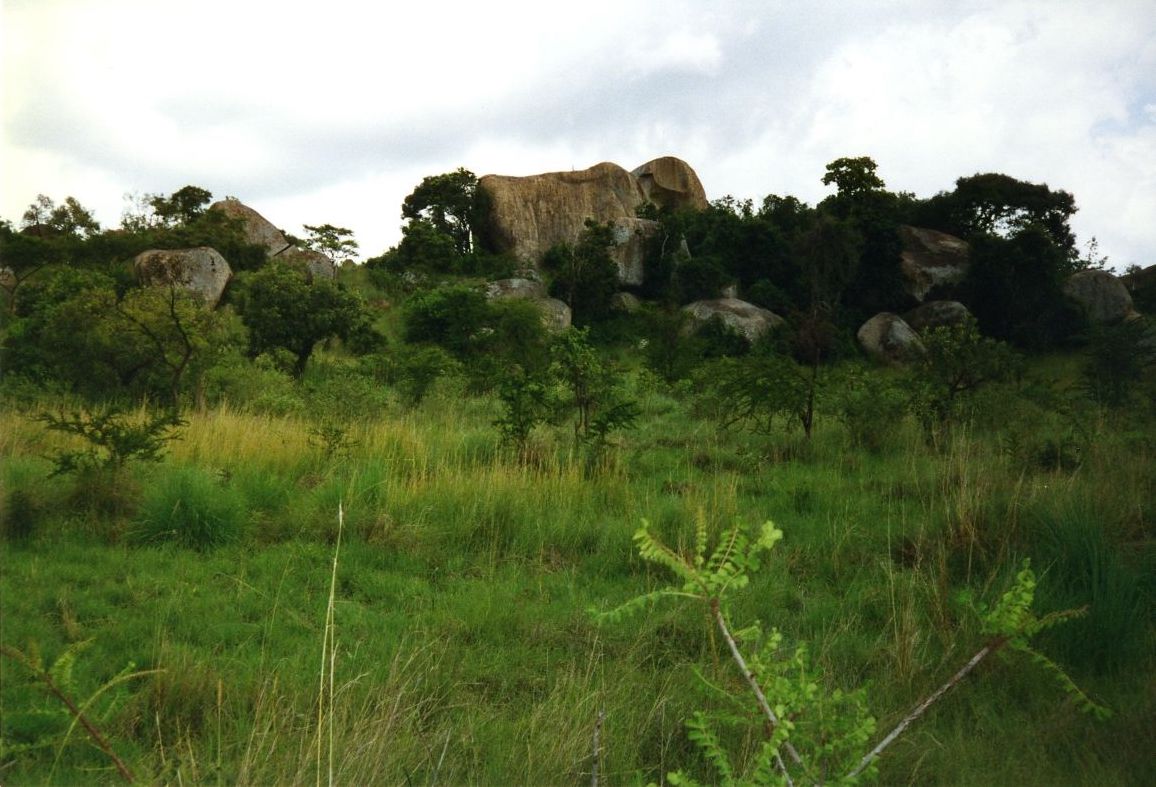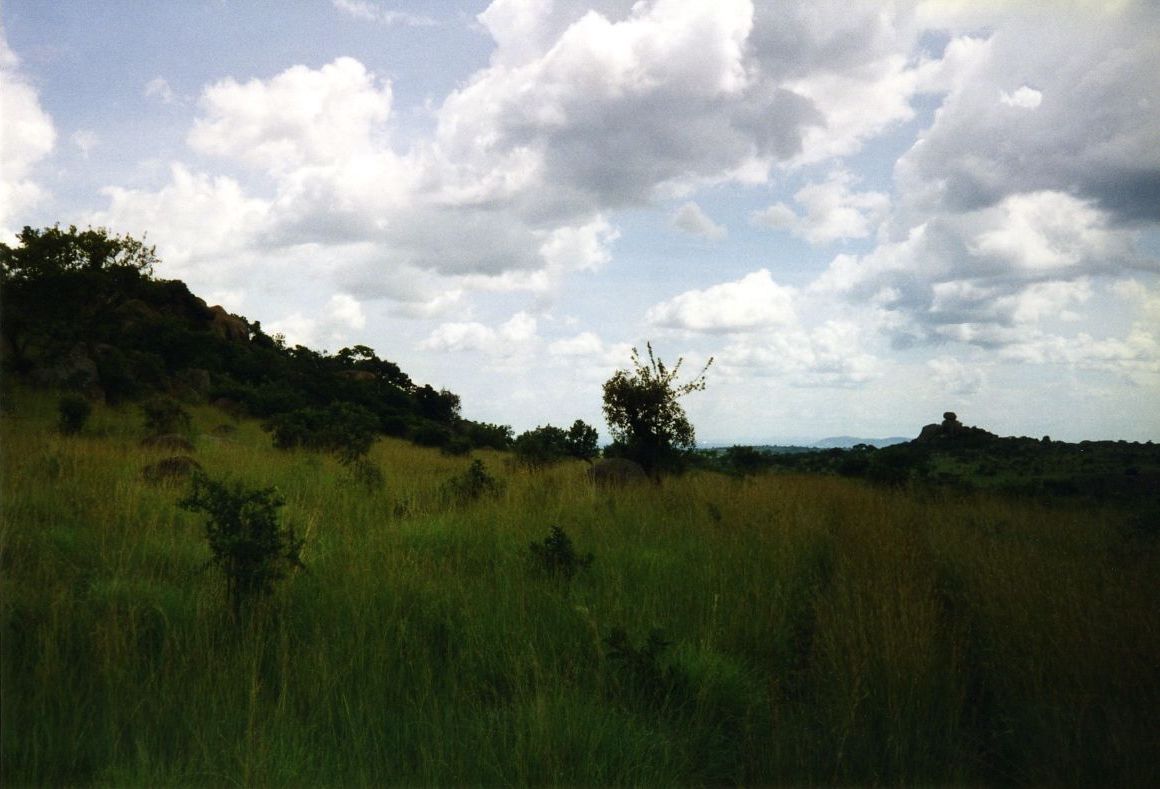Transcript
* CHECK KILUGHA PLACES, SWAHILI COMPLETE, TAPE #200
TELEGRAPH (telegraph, tape #200, side A)
Nyeberekera
Bwanda
000 -- Nyamunywa and Nyasigonko
Sochoro Kabati: She was called Nyasigonko, and Nyamunywa, who was a man. This is where they lived, the Nata began here. This was Nyasigonko's place. Nyamunywa came here as an Mtwari, they married and he was her husband. They lived here and gave birth to the Nata. ...
Jan: Ukoo of Nyasingonko?
035 -- Sochoro: Mgetiga. Ukoo of Nyamunywa was Mgaikwe. I am an Mgetiga. There is not a Gaikwe here. People do not come here to sengera, they lived here. To sengera is at Gitaraga. From here they moved to Gitaraga. Then they went to Sangang'a, there where the wife of Gitaraga lived. Then they went to Kyasigeta and Nyabuta. Then to Tutuki (near there). Then to the side of the Rubana River, Kyamburi. Then to Torogoro, then they built at Mchang'ombe or Site Mosuhu and Site Mokoro. Then to Geriga. Then to Kikong'oti. Then to on the other side of the Tirina, Rakana and Moteri. All of these are mountains. This was the end.
[NOTE THAT THE SEQUENCE IS FROM EAST TO WEST, BEGINNING AT GITARAGA AND ENDING AT RAKANA, NOTE ALSO THAT ALL ARE HILLS]
145 -- Jan: The Famine of the legs before or after Rakana and Moteri
Nyawagamba: They were at Kikong'oti.
Sochoro: At the time of the hunger they left King'oti, he gave them the Nyangi there, then they went (some to Kuria, Ngoreme, Sukuma for food), they went when the famine was done they settled at Rakana and Moderi. Then they moved back here. They built at their abandoned places. Others went to Tutuki. Others went to Sanganga. Tutuki and Sanganga.
185 -- Megassa... Turumunta is where the Saye built, Rumarancha at Getenga, Wangirate at Tutuki. this is the end.. Bongirate left Tutuki to go to Sukuma at time of hunger.
208 -- Jan: When they were first at Sanganga had they already divided into Saiga.
211 -- Sochoro: they had already divided, into Hamate. Rumarancha at Sanganga. others Getenga. others at Torogoro -- the Saye. others ... Even at the beginning they were not all at one settlement, the Rumarancha in their own place, the Ngirate separate the Saye separate. They were near to each other.
Jan: if Nyamunywa and Nyasigonko were Getiga and Gaikwe did Moriho and Mwancha come later?
Sochoro: They were born. When the children were born, eight children, boys and girls, began to name them, Moriho, Getiga, Gaikwe...
Jan: Issenye are close, did you come first or did you live together?
Sochoro: They came first, ...
Makuru: The Nata came first.
Sochoro: In the past the Nata would build and leave and then the Isenye would move in afterwards, because of the Masai. When they left here they went to Gitaraga. The Isenye came in after they left to Nyeberekera. When the Nata were at Gitaraga the Isenye were at Nyeberekera. When the Nata left Gitaraga the Isenye move up. Came to Tumunta. Nyetemunta. Temota. This was all Nata area but they moved in.
Makuru: Long ago when the Maasai were a problem and they fought in battles, here, at these mountains, they took the women and children and old people, and hid them in the hills, the men went to fight.
301 -- Jan: Did they built Oruaki here?
Sochoro and Makuru: They did not build Oruaki here. This was enough for a fortress because no enemy would not go up into the rocks to find them, the men were all down below to fight. The women, children and old people were hidden in the rocks.
Jan: how many generations since then?
Sochoro: The only remembrance we have is that the Bangirate, they were the Nata of zamani. Amasura they were Rumarancha. The Amaina were Wasaye. They are the first ones that we know. Before that we do not know. Wangirate gave birth to Kong'ota gave birth to our fathers who gave birth to us, we are Wangirate again.
345 -- Sochoro: Nyasigonko farmed with a stick... like this... eroso. When she got a husband they made a koromo. They farmed without a jembe. Koromo is with iron? Farmed millet, sorghum, chahende, seseame. She used to eat it raw. Nyamunywa was a man and he hunted, he had fire. He made fire by twirling a stick. When they met they were surprised to see another person. Nyamunywa approached her. He said where do you live? She said I live here in the rocks. He said don't you get rained on? She said yes but what should I do, I live. He said what do you eat? She said, I eat this. He said is it good? She said , eeeh. He said I eat meat. She said, raw? He said no. How do you do it? I know how to make fire. I am going now over there to excrete the fire. But he really went to twirl the sticks to make fire. Fire came to roast meat. Nyamunywa knew fire, was Gaikwe.
Jan: Did he also know iron?
Sochoro: No he killed the animals with a wooden arrow. Slept in a blind and shot them when they came.
425 -- Peter: Do the Isenye have this story?
Joseph: Yes, of Nyamnywa? We have one about a man who met a woman just like this. It was... who? Iyancha? No. the woman was... Man was... Mogunyi and Iyancha. reminded him of it. don't know if they were hunter and farmer. It was there to the east. Guka and Gukana, Gukacha. When they came to Nyeberekera they already had the clans. Came from Guka and Gukana. It is the pori over there, people who walk the pori know it. Over at Klein's camp going to Balagonga springs. The large hill over there, mountain. They were dispersed here at Nyaberekera.
483 -- Sochoro: But all of us came from one place, over there...
Jan: Do the Issenye have the origins of Abaasi who were hunters?
Joseph: Mogunyi. Iyancha -- don't know their origins. Pure Issenye. First man and first woman. Not Ngoreme and Ikoma from them.
Sochoro: Ngorongoro -- place of Ikoma, Niware, all from Ngorongoro -- Isenye, Ikoma. Miware is where Ikoma say they come from. Amaguha. mguu wake mrefu. Came from over there to here.
seems as if the tape is left on in the car, no voices to be heard, car noises, don't know if it was intentional or not, cannnot make out the conversation....
# 200 COMPLETE
{TAPE # 200, DONE BY NYAMUSI MAGATTI, AUGUST 2009}
{SIDE A}
Nyamgamba: basi nipe ile historia tena ya Nyamuna na Nyasigongo?
Sochoro: {kilugha}alikuwa anaitwa Nyasigongo na Nyamuna, yani Nyamuna ni bwana yake, Nyasigongo ni mwanamke sasa hapahapa ndio kwao, ndio walianzia hapa kwa wanata
Nyamgamba: ilikuwa nyumba ya kwa Nyasigongo au kwa Nyamuna ambaye ali..?
Sochoro: ilikuwa kwa Nyasigongo, Nyamuna alimuingilia kama nani kama mtwari, sasa wakaoana akawa ni bwana wake wakazaa wanata
Nyamgamba: haha na ukoo wa Nyasigongo?
Sochoro: ukoo wa Nyasigongo ni mgetiga halafu ukoo wa Nyamuna ni bagesa sasa wagetiga ndio akina mimi, sasa mgesi mwenyewe hayupo hapa, sasa mgetiga ndio mimi mwenyewe niko hapa
Nyamgamba: aah sawa lakini watu hawaji hapa kusengera?
Sochoro: haha ilikuwa ni kujenga tu
Nyamgamba: kwahiyo walipotoka hapa wakaelekea sehemu gani?
Sochoro: wakaelekea sehemu ya Gitaraga
Nyamgamba: haha walipotoka Gitaraga wakaenda?
Sochoro: wakaenda Sang#ang#a, ndio kule mlisema mnataka kwenda mkaona mmechelewa kwa mwanamke wa Gitaraga
Nyamgamba: baada ya Sang#ang#a wakaenda?
Sochoro: wakaenda Gasigeta
Nyamgamba: Gasigeta haha baada ya Gasigeta?
Sochoro: wakaenda Tutuki
Nyamgamba: Tutuki ni wapi?
Sochoro: aah hapo hapo
Nyamgamba: halafu baada ya Tutuki wakaenda?
Sochoro: kutoka Tutuki sasa wakaenda sehemu moja ng#ambo ya Rubana inaitwa Kiamburi.. halafu kutoka hapo wakaenda Torogoro, si Torogoro mko nayo kule?
Nyamgamba: eeh tuko nayo huko
Sochoro: eeh halafu wakatoka hapo wakajenga kuna mlima mmoja hapo unaitwa mlima {kilugha}
A: {kilugha}
Sochoro: kuna site moja mdogo uko upande hii halafu kuna site moja mkubwa sana
A: {Kilugha}
Sochoro: walivyotoka hapo wakaenda {kilugha}#hapohapo halafu wakitoka hapo sasa wakaenda wakateremka wakajenga wakaenda Kikong#oti ni hapo hapo
Nyamgamba: sawa
Sochoro: kutoka hapo Kikong#oti wakaenda ng#ambo ya Kirina sasa kunaitwa Harakana na mwateri na vyote ni vilima vilima vilima mmh baada ya kufika hapo wakafika mwisho
Nyamgamba: sasa ile njaa ya Mogoro ilikuwa kabla ya kwenda Hrakana na Muteri au baada ya?
A: walikuwa bado wako Kinong#oti
Nyamgamba: wakati wa njaa..
A: eeh wakati wa njaa ndio walitoka hapo Kikong#oti hapo
Nyamgamba: ndio Kikong#oti akawapa ile ya nyangi
A: yani akawapa nyangi hapohapo
Nyamgamba: haha halafu wakaenda sukuma
A: haha sukuma hapana
Nyamgamba: wakati wa njaa?
A: wakati huo wa njaa walikuwa wengine wanakwenda huko kurya wengine wanakwenda sukuma lakini sasa wakaenda wakati wa njaa imeisha sasa ndio wakaenda Harakana na Muteri, waliotoka hapa tena wakarudi huku wakajenga kwenye Matongo yake yale wengine wakarudi wapi, wakarudi Sutuki tena, wengine wakarudi Sang#ang#a sasa Sang#ang#a hapo pamoja na Sutuki hapo {kilugha}sasa walijenga hapo Turumonta, sasa waliojenga hapo ni wasai, maana warumaranja nao wako Tetenga, wangerati wako Tutuki sasa nimekomea
Nyamgamba: bungerati walikuwa wapi?
A: Tutuki
Nyamgamba: Tutuki?
A: mmh ndio walihama sasa kwasababu ya njaa wakaenda sukuma
Nyamgamba: aah hii ilikuwa kabla ya njaa
A: eeh hii ilikuwa kabla ya njaa
Nyamgamba: haha lakini hata wakati walikuwa ile ya kwanza walipokuwa wanakaa sang#anga walikuwa wameshagawanyika katika sega bungerati?
A: eeh waligawanyika hamati sasa, warumaranja wanajenga mbali
Nyamgamba: lakini wote Sang#ang#a?
A: eeh hawa wako Sang#ang#a hawa wako Tetenga wengine wako Torogoro, wasai
Nyamgamba: maana ulisema walitoka hapo wakaenda Gitaraga, wakatoka Gitaraga wanaenda sang#ang#a, wakatoka Sang#ang#a wanaenda Gisegeta, sasa nauliza wakati ule walikuwa wote pamoja au walikuwa wanakaa mbali?
A: walikuwa wanakaa vilevile wanasambaa, warumaranja mbali, wangerati mbali, wasai mbali, wanafuatana tu wako karibu na hawa wako karibu
Nyamgamba: kama Nyasigongo alikuwa mgetiga na Nyamuna alikuwa mgaikwe sasa hawa hawa wa moriho na wa mwancha wakaja baadaye au?
A: ni kuzaliwa kwa mtoto sasa
Nyamgamba: aah ni kuzaliwa?
A: eeh sasa wakishazaa watoto wanazaa watoto wa kike na wanaume sasa walikuwa ni watu wadogo tu, mzazi moja sasa hawa wakaanza majina sasa huyu Moriho huyu Mgetiga
Nyamgamba: sasa tunapokuwa hapa leo tunaona hawa wa Isenye iko karibu hapa sasa ilikuwa kwamba nyinyi mlitangulia au mlikuwa mnaishi?
A: hawa ndio walitangulia hapa
Nyamgamba: nani?
A: {kilugha}
Nyamgamba: nani alitangulia?
A: kujenga hapa..wanata unajua zamani wanata wakijenga wakitoka wa isenye wanaingia kwasababu ya maasai
Nyamgamba: haha
A: walihama hapa wakaenda Gitaraga, na Isenye nao wakajenga wapi, wako hapahapa
Nyamgamba: kwahiyo wakati nyinyi mlikuwa Gitaraga na wao wakaingia
A: walikuwa pande hii, walipohama hapa wakaenda muisenye wakasogea eeh wakaja sehemu moja inaitwa Kimota, kuna sehemu yao walijenga hapo inaitwa Kimota
Sochoro: {kilugha}
Nyamgamba: Nyentimunta ni sehemu ya nani, ya waisenye?
A: Kimota ni Nata jumla lakini hawa kuhama walikuwa wanahama wanajenga, pote hapo ilikuwa sehemu ya Nata
Sochoro: unajua hapo wakati wa zamani wa maasai walikuwa wanacheza sana pamoja na wanata wanapigana vita unauona huu mlima una miamba haya ndio walikuwa wanatoa wanawake, wale wazee sana na watoto wanakuja kuwaficha humu kwasababu wanaume wanaenda kupigana na wa maasai
Nyamgamba: hapa walijenga ile rwaki kama walivyojenga huko?
Sochoro: hapo kulikuwa hakuna rwaki kwasababu kulikuwa hakuna adui yeyote atakayekuja kuchungulia kuona kuna nani, wanaume wote wako huko chini huko wanapigana vita, watoto na wazee na wanawake wote wako humu
Nyamgamba: mmh# sawa na hakuna kumbukumbu kuna vizazi vingapi vimetokea tangu walipokuwa hapa?
Sochoro: aah kumbukumbu tunaojua ni bangerati
Nyamgamba: aah ndio
Sochoro: wangerati ndio tunaelewa kwamba wangerati walikuwa wanata wa zamani sasa halafu hapo kuna Masura hawa ni warumaranja sasa halafu kuna wengine w amaina ni wasai sasa, sasa hapo ndipo ndio tunawaanza kuwajua kwasababu tulivyoanza kuwajua walishatoka humu zamani sana, tena wanasahau kabisa, sasa unaona wale wangerati ndio walizaa wakung#uta halafu wakung#uta walizaa wababa zetu halafu wababa zetu wanatuzaa halafu sisi sasa ndio wangerati
Nyamgamba: eeh ndio na huyu Nyasigongo alikuwa analima na ile mti?
Sochoro: alikuwa analima na ile mti, alikuwa analima na mti tu kama hii, ndio alikuwa analimia
Nyamgamba: ilikuwa inaitwa?
Sochoro: hii iroso
Nyamgamba: iroso?
Sochoro: eeh halafu akija kupata bwana sasa ndio wakaunda tena, wakatengeneza koroma sasa kama hii sasa ndio walikuwa wanalimia bila jembe
Nyamgamba: aah lakini koroma pia ni ya mti?
Sochoro: koroma pia ni ya mti, unajua walikuwa wanchonga vizuri sana, yeyé Nyasigongo alikuwa analima ulezi halafu alikuwa analima mchama halafu alikuwa analima {kilugha} kazi yake ilikuwa ni hiyo, lakini kula kwake alikuwa anakula mbichi eeh sasa Nyamuna naye alikuwa ni mwanamme kazi yake ni kuwinda anaua wanyama, sasa yeyé ndiye alikuwa na moto sasa ndio anatengeneza moto anachekecha hivi, wakati wa kuonana na yule mwanamke wakashtukana naona kama yule ni mwanamke na yeyé anaona kama yule ni mwanamme sasa unajua wanaume wakaishi sana akamsogelea, yule mama akasogea akamwambia acha kukimbia, acha kukimbia simama sasa akaenda kwake kufika akamuuliza unakaa wapi, akasema mimi nakaa hapa, akamuuliza kweli hunyeshewi, akasema nanyeshewa lakini nitafanya nini, nakaa tu, sasa unakula nini, akasema sasa unakula nini, akasema mimi nakula hii, ni nzuri, akasema eeh sasa wewe bwana unakula nini akasema mimi nakula nyama. Mbichi akasema hapana, akamwambia mama toka hapa niende huku nikatengeneze moto akaenda ndio sasa moto ikapatikana wakaanza kuchoma nyama halafu na kupiga ile chakula
Nyamgamba: na Nyamuna alikuwa anajua moto?
Sochoro: yeyé alikuwa anajua moto
Nyamgamba: alijua vyuma pia au hakujua?
Sochoro: haha yule mnyama alikuwa anapiga na mti anachonga mti, sasa unajua alikuwa anakwenda anakaa mnyama anakuja akifika kwake anapiga
Nyamgamba: haha# aaah kumbe
A: na sisi ilikuwa mwanamme na mwanamke wakaoana hivyo hivyo
Nyamgamba: wakakutana nani na nani?
A: wakakutana#nimewasahau
Nyamgamba: Inyancha?
A: hata mimi nawafahamu ndio waliozaa wa Isenye {kilugha}
Nyamgamba: sasa na wao walikuwa mwindaji na mkulima au historia yao ni ipi?
A: hapo sielewi vizuri lakini vilevile ni mwanamme na mwanamke waliokutana ni watu walikutana vilevile porini wakaoana, ni mbele ya hapa mashariki hapo ndio wa Isenye wakazaana milango ikapatikana, lakini walipooana ni huko mashariki, kwenye milima waliotokea wa Isenye
Nyamgamba: umeshafika Bukwe
A: sana
Nyamgamba: oooh
Sochoro: kwasababu hawa ni watu wanatembea porini wanajua sana, vyote wanajua {kilugha}
Nyamgamba: aah kumbe ile mlima ule ukitoka, ile ambayo#ndio Guko? Aah kumbe sawa
A: ndiko tulikotokea, ndio tukaja hapa
Sochoro: lakini mimi nafikiri watu wote hawa tuliotokea sehemu ni sehemu moja huku
Nyamgamba: lakini wa Isenye hawana asili kama kuna mwasi ambayo alikuwa mzazi moja? Maana hawa mwasi ni huyu Nyamuna
Sochoro: unasema huyu Mwancha na huyu ndio waliozaa Mshiri, na Muikoma wakazaa na mngorime, sasa wao walitokea Nyancha, ilikuwa asili yake mgunya
A: wao pia ni wa Isenye ni watu waliooana mme na mke wakaoona huko wakazaa
Sochoro: unajua watu mama wakati wa kupatikana wanasema kwamba wanapatikana, unajua Ngorongoro sehemu ya nyumba ya {kilugha}
Nyamgamba:ndipo inaitwa Riwari?
Sochoro: wa Ikoma wanasema Riwari, watu wote unajua walitokea huko lakini kwisha kwa watu ni haraka sana, sasa watu waliopatikana hawa, sasa sijui ni vizazi vingapi ikapatikana, halafu wale {kilugha}
Nyamgamba: aah sawa kwahiyo sijui#
{END OF SIDE A}
{THE REST OF THE TAPE, IS TAPED OVER, NOT CLEAR}
{THE END OF TAPE # 200, DONE BY NYAMUSI MAGATTI, AUGUST, 2009}
Show Full Transcript
Download Transcript PDF

